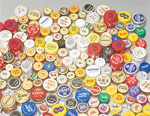Beverage Cans
Aluminum Alloy Sheets for Closures (Beverage Container Caps)Caps for Beverage Bottle Cans, Glass Bottles and Other Containers

Closures (stoppers) are the items that close various types of container. Aluminum closures are used to seal a wide variety of glass bottles and bottle cans for soft drinks, nutritional drinks and the like. We provide closure sheet materials to meet customer needs for closures that protect a container's contents, open easily and are highly convenient.
Features
- Chemical composition and rolling reduction and temperature can be adjusted to achieve higher material strength, allowing the sheet gauge to be reduced (making them lighter).
- We control material composition, rolling temperature and time, and annealing temperature to produce optimal materials to meet clients’ performance needs, such as its opening capability and earing.
- If requested, we treat materials with phosphoric acid chromate or zirconium to improve paint adherence.
- We carefully monitor flatness and squareness to prevent color gapping, unevenness or print misalignment during printing.
Product Characteristics
| Principal alloys | Applications | Characteristics |
|---|---|---|
| 3105 | General-purpose materials | Formability is good, and strength can be standardized to meet product demands. |
| 5355 | Specialized bottle cans | Material characteristics are similar to can-end stock materials, making them stronger. |
Cap Production Process
Printing process
![]()
![]()
Known as a “size coat,” foundation processing is conducted to help the paint adhere better. Products that are processed using phosphoric acid chromate or zirconium are often cut.
![]()
Either the public side or the product side surface may be painted first, depending on the product.
![]()
The number of printing passes depends on the image to be printed on the cap.
![]()
Glossy varnish
![]()
A single slitter method is used to cut the sheet into three equal strips. For some products, both edges are trimmed at this time.
Press Process
![]()
The cut printing plate is run through the press to create the cap shape (straight side walls).
![]()
The bottom edge of the formed cap is trimmed off (broken off) or curled.

Adhesive joining
![]()
Protrusions are formed on the sides of the cap, near the top, to prevent slippage when twisting the lid open.
![]()
Perforations are added to ensure that when the lid is twisted open, the TE band (ring) remains behind.

1st Pressing
Leave a hat-like shape at the base of the pressing.

2nd Pressing
At the same time as the first pressing, the hat-shaped edge is trimmed away.

Knurling
Knurls are added as the cap rotates.

Perforation

